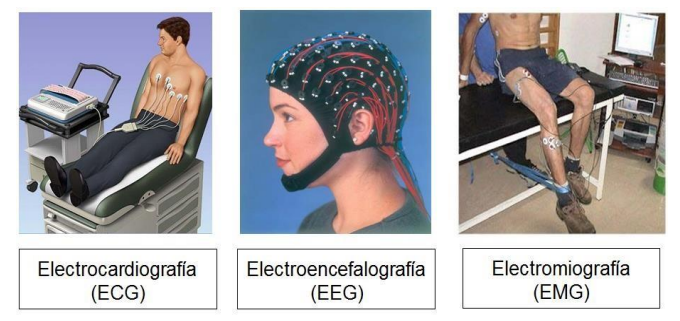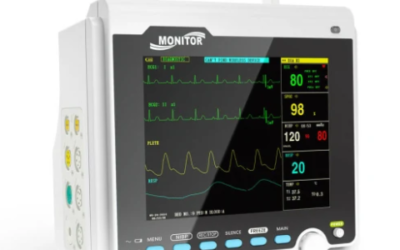Bioelectrodes are fundamental devices in clinical engineering for biomedical monitoring. In this article, we will explore the technological advances of bioelectrodes and their impact on healthcare and accurate disease diagnosis.
Índice del Articulo
What are bioelectrodes?
Bioelectrodes are devices used to measure electrical signals generated by biological processes or to provide electrical stimuli to biological tissues. These electrodes are designed to interact with biological systems, such as tissues, cells, or body fluids, in order to record or modify electrical signals. There are several types of bioelectrodes, each designed for specific applications. Here are some common examples:
Recording or Sensory Electrodes:
These bioelectrodes are used to measure electrical signals generated by biological systems. Recording electrodes are commonly used in electroencephalography (EEG), electrocardiography (ECG), electromyography (EMG) and other bioelectrical monitoring techniques.
Stimulation Electrodes:
Designed to provide electrical stimuli to biological tissues. These are used in applications such as electrical nerve stimulation (ENS), electroshock therapy, and other forms of electrostimulation.
pH Electrodes:
Used to measure the level of acidity or alkalinity of a biological environment. pH electrodes are crucial in applications such as monitoring acidity in blood or biological solutions.
Ion Selective Electrodes:
Specific for measuring specific ions, such as sodium, potassium, calcium, etc. ion electrodes. These are used in monitoring ionic concentration in biological fluids.
Oxygen Electrodes:
Designed to measure oxygen concentration in biological tissues or fluids. These are common in applications such as monitoring blood oxygenation.
Glucose Electrodes:
Used in measuring glucose concentration in biological fluids, such as blood. These are essential in continuous glucose monitoring devices, such as those used by people with diabetes.
Intracellular Recording Electrodes:
Used for the measurement of intracellular action potentials and other electrical signals within living cells.
Surface and Needle Electrodes:
Depending on the application, bioelectrodes may be surface electrodes, such as those used in EEG or ECG, or they may be needles or microelectrodes used for more invasive applications, such as tissue stimulation or measurement of intracellular signals.
In general, bioelectrodes are essential tools in biomedical research, clinical diagnosis, and the application of therapies based on electrical stimulation. Their design and material may vary depending on the specific application and the requirements of the biomedical procedure in which they are used.

Applications of bioelectrodes in clinical engineering:
Bioelectrodes have a wide variety of applications in clinical engineering, contributing to the diagnosis, monitoring and treatment of various medical conditions. Some of the key applications of bioelectrodes in this context are presented here:
Electroencephalography (EEG):
Electroencephalography (EEG) involves recording the electrical activity of the brain. This application is carried out by using bioelectrodes, which are surface electrodes placed on the scalp to measure brain waves.
Electrocardiography (ECG):
Electrocardiography (ECG) is used to evaluate the electrical activity of the heart. This application involves the use of bioelectrodes, placed on the chest, limbs, and other areas, to record cardiac electrical activity.
Electromyography (EMG):
Electromyography (EMG) is used to evaluate the electrical activity of muscles. In this process, bioelectrodes, which can be surface electrodes or needles, are placed on the muscles to record muscular electrical activity.
Electrical Nerve Stimulation (ENS):
Electrical Nerve Stimulation (ENS) is applied to treat neuromuscular conditions or chronic pain by electrically stimulating the nerves. This technique uses bioelectrodes, placed near nerves or in specific areas of the body, to carry out electrical stimulation.
Continuous Glucose Monitoring:
Continuous glucose monitoring is used for the constant monitoring of glucose levels in people with diabetes. In this process, glucose sensors that use bioelectrodes are used to measure glucose levels in the interstitial fluid.
pH and Blood Gas Measurement:
The application focuses on monitoring the acidity and levels of oxygen and carbon dioxide in the blood. To carry out this measurement, specific bioelectrodes are used, such as electrodes for measuring pH, and gas sensors for the measurement of oxygen and carbon dioxide.
Deep Brain Stimulation (DBS):
The application focuses on the treatment of neurological disorders by electrical stimulation of specific areas of the brain. In this process, bioelectrodes are used which are electrodes implanted in the brain to provide the necessary electrical stimulation.
Cardiac Electrophysiology:
Cardiac electrophysiology is used for mapping and assessing the electrical activity of the heart in cardiac procedures. To perform this assessment, bioelectrodes are used, which are electrodes used on catheters to record the electrical activity of the heart during invasive procedures.
Muscle Activity Monitoring:
Muscle activity monitoring is applied for the assessment of muscle function and rehabilitation. In this process, bioelectrodes, placed on the surface of muscles, are used to measure electrical activity during movement, allowing monitoring and analysis of muscle activity.
Implantable Biosensors:
Implantable biosensors are used for continuous monitoring of biomarkers or specific parameters within the body. These devices include bioelectrodes, which are electrodes integrated into implantable devices, designed for the detection and measurement of specific substances in the body.
These applications illustrate the versatility and importance of bioelectrodes in clinical engineering to facilitate accurate diagnoses, real-time monitoring, and targeted treatments based on electrical stimulation. The continued development of bioelectrode technologies contributes to significant advances in healthcare and improved quality of life for patients.

Technological advances in bioelectrodes:
Bioelectrodes have seen significant advancements in terms of technology and design, which has expanded their capabilities and applications in the field of clinical and biomedical engineering. Some of the notable technological advancements in bioelectrodes include:
Flexible Bioelectrodes:
Flexible bioelectrodes are characterized by their thin and flexible design, which optimally adapts to the surface of the body. These offer benefits such as increased comfort for patients, the ability to conform to body curves, and improved quality of recorded signals.
Textile Bioelectrodes:
Textile bioelectrodes are characterized by the integration of conductive textile materials in the manufacture of electrodes. This provides benefits such as increased comfort, flexibility, and breathability, facilitating integration with clothing and improving user experience.
Nanotechnology in Bioelectrodes:
Nanotechnology in bioelectrodes involves the use of nanomaterials to improve the electrical properties and sensitivity of biological electrodes. This results in benefits such as increased sensitivity in the detection of bioelectrical signals, reduced electrode size, and improved interface with biological tissues.
Advanced Implantable Electrodes:
Advanced implantable electrodes are characterized by their smaller, more flexible, and biocompatible design. These electrodes offer benefits such as reduced tissue trauma, increased durability, and lower risk of rejection, allowing for long-term application in various medical applications.
Dry and Gel-Free Electrodes:
Dry and gel-free electrodes are characterized by the elimination of the use of conductive gel, making them more practical and comfortable. These offer benefits such as greater ease of use, less mess, and less need for preparation, thus improving the patient experience during their application.
Wireless Electrodes:
Wireless electrodes stand out for using wireless technologies for signal transmission from the electrodes. This leads to benefits such as greater mobility and comfort for the patient by eliminating cables, facilitating remote and continuous monitoring.
Multi-Function Bioelectrodes:
Multi-function bioelectrodes are characterized by integrating various functions into a single electrode, such as the ability to measure different bioelectrical parameters. This provides benefits such as greater versatility and efficiency in clinical applications, reducing the need to use multiple types of electrodes for different purposes.
Smart Electrodes:
Smart electrodes are characterized by the incorporation of additional sensors, microchips, or smart technologies. These offer benefits such as enhanced monitoring capabilities, real-time data processing, and adaptability to specific clinical needs, contributing to more advanced and personalized management of bioelectrical information.
Brain-Computer Interface (BCI) Design:
Brain-computer interface (BCI) design involves the development of bioelectrodes for applications that facilitate direct communication between the brain and external devices. These bioelectrodes offer significant benefits by enabling interaction for people with motor disabilities, opening up new therapeutic possibilities and improving quality of life.
Nanoparticle Biosensors:
Nanoparticle biosensors are characterized by the use of nanoparticles in their manufacture, which improves sensitivity and specificity. These biosensors offer significant benefits by allowing more accurate detection of biomarkers and specific substances, being especially useful in applications such as implantable biosensors.
These advances in bioelectrode technology contribute to improved accuracy, patient comfort, and versatility in a variety of clinical and research applications. Continued research and development in this field promise to continue to expand the capabilities and applications of bioelectrodes in the future.

Benefits of using bioelectrodes in healthcare:
The use of bioelectrodes in healthcare offers a number of significant benefits ranging from diagnosis to treatment to continuous monitoring. Here are some of the key benefits:
Accurate Diagnosis:
Bioelectrodes allow for the capture of bioelectrical signals directly from the body, facilitating the accurate diagnosis of various medical conditions such as neuromuscular, cardiac or brain disorders.
Continuous Monitoring:
The ability to use bioelectrodes for continuous monitoring of various physiological functions provides real-time information on the patient’s health status. This is especially valuable in critical settings or for monitoring chronic diseases.
Individualization of Treatment:
Bioelectrodes allow for the customization of treatments such as electrical stimulation, tailoring them to the specific needs of each patient. This is particularly important in therapies such as deep brain stimulation (DBS) for neurological disorders.
Reduced Invasiveness:
Advances in bioelectrode technology, such as smaller and more flexible implantable electrodes, contribute to reducing the invasiveness of procedures, minimizing tissue trauma and speeding recovery.
Improving Patient Experience:
The incorporation of more comfortable and less intrusive bioelectrodes, such as flexible and textile electrodes, improves the patient experience during prolonged monitoring procedures.
Applications in Neuroscience and BCI:
In the brain-computer interface (BCI), bioelectrodes allow direct communication between the brain and external devices, providing new opportunities for people with motor disabilities and neurological disorders.
Early Detection of Abnormalities:
Bioelectrodes are useful for early detection of electrical abnormalities in organs such as the heart or brain, facilitating early intervention and prevention of complications.
Biomarker Monitoring:
Bioelectrodes used in biosensors allow for the monitoring of specific biomarkers, which is crucial for early detection and monitoring of diseases such as diabetes.
Biomedical Research:
In the field of research, bioelectrodes are essential tools for studying electrical activity in biological systems, providing valuable information for understanding physiology and pathology.
Improving Stimulation Therapies:
Bioelectrodes used in electrical stimulation therapies, such as ENS or DBS, offer more effective and less invasive treatment options for neuromuscular and neuropsychiatric conditions.
Facilitating Rehabilitation Therapies:
In rehabilitation, bioelectrodes allow for monitoring of muscle activity and facilitate real-time feedback, improving the effectiveness of recovery therapies.
Telemetry and Remote Monitoring:
Wireless bioelectrodes facilitate telemetry and remote monitoring, allowing patients to be monitored outside of the clinical setting, which is beneficial for remote care and long-term follow-up.
In summary, the use of bioelectrodes in healthcare provides substantial benefits by enabling more accurate diagnoses, personalized treatments, continuous monitoring, and an overall improvement in patient care. These advances contribute to more effective, less invasive, and patient-centered healthcare.

Frequently asked questions about bioelectrodes:
What are bioelectrodes?
Bioelectrodes are devices used to record electrical signals in biological environments. They are designed to interact with biological tissues and capture electrical signals, such as those generated by cells or tissues.
What are the common applications of bioelectrodes?
Bioelectrodes are used in electroencephalography (EEG), electrocardiography (ECG), neuromuscular stimulation, brain activity monitoring, and other medical and research applications.
How do bioelectrodes work in recording electrical signals?
Bioelectrodes allow the conduction of electric current between the body and the recording system. This is achieved through electrodes that establish contact with the skin or tissues, capturing the generated electrical signals.
What is the importance of bioelectrode quality in biomedical records?
The quality of bioelectrodes directly influences the accuracy of biomedical measurements. Good electrical contact and proper design are essential to obtain reliable data and avoid artifacts in the recordings.
How are bioelectrodes placed on the skin correctly?
Accurate placement of bioelectrodes is crucial. International standards for specific placement on the body are followed, ensuring consistent and comparable measurements across different studies and patients.
What are the different types of bioelectrodes available?
There are several types, such as solid metal electrodes, gel electrodes, dry electrodes, and intracorporeal electrodes. Each type has its own advantages and disadvantages, and the choice depends on the specific application.
How are bioelectrodes maintained?
Maintenance involves regular cleaning, checking the integrity of the wiring and replacing worn electrodes. In addition, following the manufacturer’s recommendations is essential to prolong the life and quality of the recordings.
What are the common challenges associated with the use of bioelectrodes?
Issues such as electrode impedance, external interference, and patient movement can affect recordings. Staff training and proper electrode selection are key to addressing these challenges.
Can bioelectrodes be reused?
Some bioelectrodes are designed for single use, while others can be sterilized and reused. The choice depends on the application and the manufacturer’s recommendations.
How are bioelectrodes evolving in research and medicine?
Ongoing research seeks to improve the durability, comfort and accuracy of bioelectrodes. In addition, advances in materials and technologies are being explored to expand their application in biomedical monitoring and diagnosis.
Conclusion on bioelectrodes:
Bioelectrodes represent an essential technology in clinical engineering and biomedical monitoring. Their technological advancements have enabled more accurate and comfortable monitoring of the body’s electrical signals, which has improved disease diagnosis and management. With continued research and development in this field, bioelectrodes are expected to play an even more crucial role in personalized healthcare and improving the quality of life of patients.
Recommendation:
To deepen your knowledge of clinical engineering, I suggest you continue reading the next article that addresses: What is bioimpedance in clinical engineering?






0 Comments